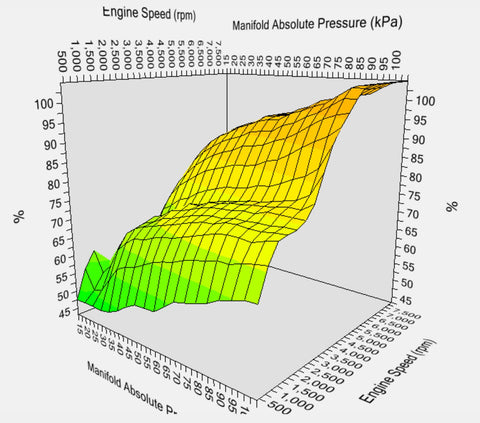What is a MAFless Tune? MAFless Tune Basics
What does MAFless actually mean? should you be using a MAFless tune? and How to Get a MAFFless Tune.
If you’ve got an LS Based vehicle or LS Swapped vehicle you’ve no doubt heard the term “MAFless”. Today we’re going to discuss what MAFless actually is, when you should and should not use a MAFless tune.
The following is applicable to Australian delivered, LS based vehicled ONLY.
What is MAFless?
To start, the MAF in “MAFless” referrers to the Mass Air Flow Sensor, this sensor directly measures the “Mass” of air entering the intake of your vehicle. In Australian Delivered LS based vehicles, this can take one of several forms. The earliest, is a 3 Pin Heated MAF sensor which looks like the one below. A separate intake air temp sensor (IAT) is included and used in conjunction with the MAF, this is located in the factory airbox.

VX VY Intake Air Temp Sensor

VX VY MAF Sensor
From the VZ commodore, the MAF went to a 5-wire unit which includes the intake air temp sensor inside the MAF. The VE - VF MAF is different but is still a 5-wire sensor which contains the Intake Air Temp Sensor inside the MAF.

VE VF 5 Wire MAF
Going MAFless or a MAFless tune, refers to the changing of the operating system inside the PCM or ECM to no longer require the MAF to calculate the mass of air that is entering the cylinders. This is known as a “Speed Density” operating principle and is how most aftermarket ECU’s operate.
Speed Density uses what’s known as Volumetric Efficiency to determine the mass of air and therefore the fuelling for the engine. Explaining Volumetric Efficiency in depth could have its own book written about it as it’s a complex topic, but the basics are, Volumetric Efficiency is a percentage figure which shows how “efficient” the engine is, for a given manifold pressure and RPM at moving air into the cylinders.
To make it even simpler, here is a very simplified example. For a 5.7L LS1 each cylinder has roughly a 0.7125L Capacity. Now let’s say for a given RPM of 4,000 and a given manifold absolute pressure (or load) of 55kPa, the cylinder only fills up with 0.5914L of air? This results in only 83% of the capacity of the 0.7125L cylinder being full. Therefore, the VE (Volumetric Efficiency) of the engine at that given point is 83%. The volumetric efficiency is a result of the actual capacity of the engine, divided by the potential capacity of the engine.
The ECU is mapped for hundreds of different points like those above, which when combined, create a 3D map of the engine.

3D Volumetric Eficiency Table
Using this map in conjunction with the Intake Air Temp Sensor and the Throttle Position Sensor, the ECU can accurately calculate the mass of air entering the engine and therefore apply the correct amount of fuel, without needed to reference the MAF sensor.
So, if this is the case, why didn’t GM just use this from the factory?
When to go MAFless?
Like many things in the world of tuning, everything has its pro’s and con’s. The reality is, the factory operating system with the use of a MAF is better at accurately measuring airflow at steady state like cruising and Wide open throttle. The factory operating system uses a combination of Speed Density and MAF based calculations depending on the load and RPM.
However, when upgrading to a larger Cam or building a high comp, high horsepower engine, the MAF may become a restriction in the intake tract which robs horsepower, especially in Gen 3 vehicles where the MAF is small and can create a restriction. Another downside of a MAF is it doesn’t discriminate to which way the air is traveling across it. Therefore, some larger cams can create a pulse that exits the intake manifold and creates a false reading in the MAF.
Another consideration is the emissions of the vehicle. The MAF is considered part of the emissions system of the vehicle and is therefore required for engineering compliance in many states. This is, however, general advice only and you should speak to a local engineer as the rules vary state to state.
How to go MAFless
If you do decide you want to ditch the MAF, there are two considerations to make, the PCM/ECM and the Intake air temp sensor.
The PCM or ECM must be reprogrammed to run a Speed Density operating system. We offer a range of Reprogramming services which can be found HERE.
In the case of a bench reprogram which we offer, the basic tune is kept standard, only the method the engine calculates airflow is changed.
If you have modified your engine, camshaft, headers, heads etc, chances are you’ve also changed the Volumetric Efficiency profile of your engine. This requires a Dyno tune to recalibrate the volumetric efficiency table as above. A google should reveal tuners in your area.

The other consideration is the Intake air temp sensor. As explained earlier, some MAF’s contain the temp sensor within the MAF, removal of the MAF would mean removal of the temp sensor and therefore no input to the ECU. This results in an extremely lousy running vehicle. If this is the case, as MAFless patch harness is required, which plugs into your existing MAF and allows you to use a separate Intake Air Temp Sensor from an earlier model. These can be found HERE.

We help this clears up some confusion surrounding the terminology. If you have more questions about going MAFless, consult your local performance or tuning shop.
